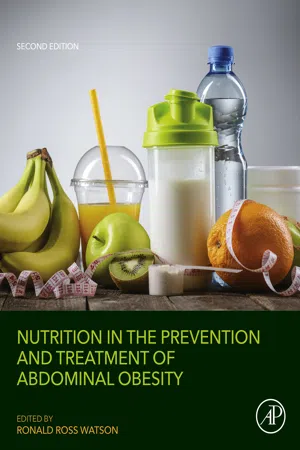
- 522 pages
- English
- ePUB (mobile friendly)
- Available on iOS & Android
Nutrition in the Prevention and Treatment of Abdominal Obesity
About this book
Nutrition in the Prevention and Treatment of Abdominal Obesity, Second Edition focuses on the important role that exercise, dietary changes and foods play in promoting and reducing visceral fat. Nutritionists, dieticians and healthcare providers seeking to address the abdominal obesity epidemic will find this book to be a valuable resource in their long-term goal of preventing chronic diseases, especially heart, vascular and diabetic diseases. Chapters define a range of dietary approaches to reduce risk for the associated chronic diseases. In addition, discussions of the importance of dietary approaches to reduce abdominal obesity, along with clinical approaches, are discussed, including costs and risks.- Serves as a starting point for in-depth discussions in academic settings that will lead to revised and updated treatment options- Offers detailed, well-documented reviews outlining the various dietary approaches to visceral obesity with their benefits and failures- Includes updated research on the gut microbiome, FGF 21 and dietary foods and supplements
Frequently asked questions
- Essential is ideal for learners and professionals who enjoy exploring a wide range of subjects. Access the Essential Library with 800,000+ trusted titles and best-sellers across business, personal growth, and the humanities. Includes unlimited reading time and Standard Read Aloud voice.
- Complete: Perfect for advanced learners and researchers needing full, unrestricted access. Unlock 1.4M+ books across hundreds of subjects, including academic and specialized titles. The Complete Plan also includes advanced features like Premium Read Aloud and Research Assistant.
Please note we cannot support devices running on iOS 13 and Android 7 or earlier. Learn more about using the app.
Information
Conjugated Linoleic Acid in Human Health: Effects on Weight Control
Abstract
Keywords
1 Introduction
Discovery and Origins of CLA
Table of contents
- Cover image
- Title page
- Table of Contents
- Copyright
- Contributors
- Acknowledgments
- Section I: Overview of Obesity and Population Studies
- Section II: Mechanisms of Obesity
- Section III: Role of Dietary Supplements in Obesity
- Section IV: Foods and Macronutrients in Obesity
- Section V: Micronutrients and Dietary Components in Obesity
- Index